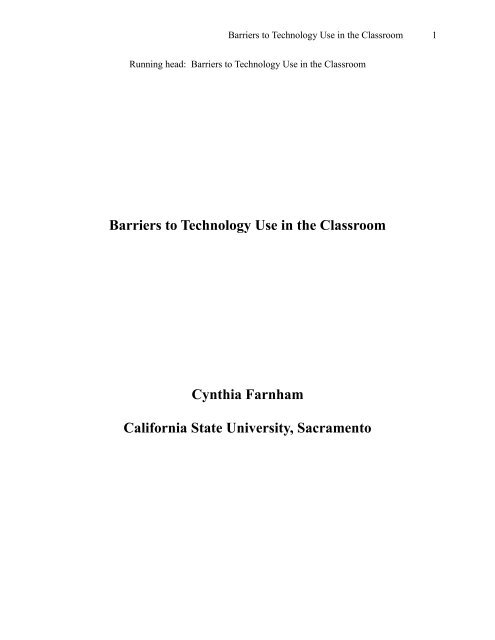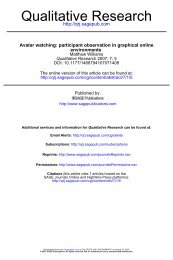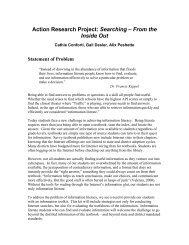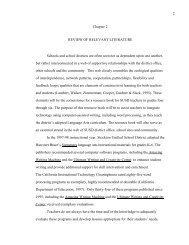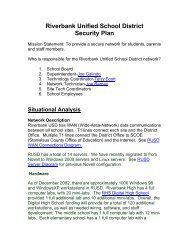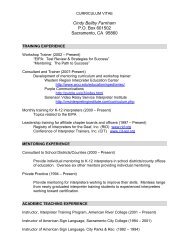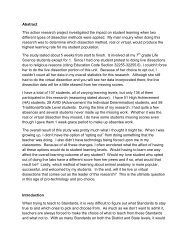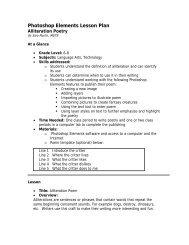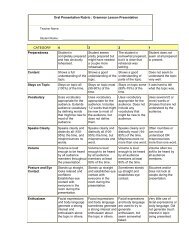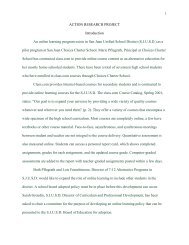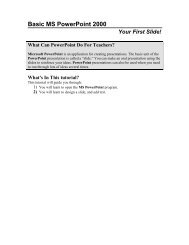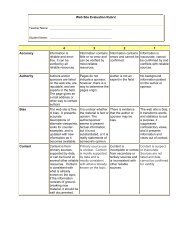Running head: A BIZARRE APPLICATION OF APA - iMET ...
Running head: A BIZARRE APPLICATION OF APA - iMET ...
Running head: A BIZARRE APPLICATION OF APA - iMET ...
Create successful ePaper yourself
Turn your PDF publications into a flip-book with our unique Google optimized e-Paper software.
Barriers to Technology Use in the Classroom 1<strong>Running</strong> <strong>head</strong>: Barriers to Technology Use in the ClassroomBarriers to Technology Use in the ClassroomCynthia FarnhamCalifornia State University, Sacramento
Barriers to Technology Use in the Classroom 2AbstractWhether in K-12 or post-secondary settings, educators face barriers to using technology in theclassroom. Brinkerhoff notes that “there is general agreement among leaders in the field ofeducational technology that, due to a variety of barriers, teachers often fail to capitalize on theeducational potential offered by technology resources.” (Brinkerhoff, 2006). This is not due to alack of training in teacher preparation programs; however the type of training delivered to futureeducators is an issue. “Numerous teacher education programs have made extensive efforts toimplement effective and meaningful use of technology, however the strategies used to attainthese goals are complex, diverse, often conflicting, and rarely evaluated well.” (Kay, 2006). Theineffective use of technology cannot be blamed on the lack of investment in increasing theavailability of technology in the classroom. Kelly states that, “Massive public investments overthe past few years have succeeded largely in providing most students with access to computersand connectivity to the Internet. But for the most part, little has been done to capture thepotential of technology. Progress is likely to be slow, because the mechanisms that driveinnovation in business simply do not work well in education markets.” (Kelly, 2005).In the education of sign language interpreters, there are interpreter preparation programs atcommunity colleges and universities. There is only one professional organization serving signlanguage interpreter educators, the Conference of Interpreter Trainers, Inc. (CIT). Thisorganization just published its first professional journal in November 2009 and none of thearticles or research specifically discusses educational technology. Over the years, it has beenrare that white papers and research presented at CIT conferences focuses on educationaltechnology. Thus there is a scarcity of literature that specifically discusses educationaltechnology and the education of sign language interpreters.
Barriers to Technology Use in the Classroom 3The literature about general education in K-12 and post-secondary institutions shows that thebarriers can be grouped in “four main categories: resources, institutional and administrativesupport, training and experience, and attitudinal or personality factors.” (Brinkerhoff, 2006).Ertmer agrees with this view and states that barriers to effective use of technology “may relate toa variety of issues including personal concerns, technical and organizational support, as well aspedagogical beliefs.” (Ertmer, 1999). A fifth category shows up often in the literature and that isthe understanding and engagement of students. These five categories of barriers are discussed inthis review of literature.Barriers to Technology Use in General EducationResourcesTime and accessibility to resources are cited as two reasons teachers do not fully utilizetechnology with their students. Educators feel they either do not have the time to learn how tointegrate the technology into their curriculum or the time to actually utilize the technology whendemands for other activities take priority. Trotter notes, “Even teachers who are enthusiasticabout using technology can run into problems when it comes to balancing the time they spendteaching academic content with the time they and their students need to learn the necessarytechnical skills.” (Trotter, 1999). One solution noted in the literature is to utilize tutoringsoftware. Kelly writes, “Studies comparing individual tutoring with classroom instructionsuggest that tutoring has spectacular impact.” If technology can be used with tutoring activities,teachers can then have the time to focus on other priorities. “A combination of well-designedcomputer systems and careful use of human resources can approach the impact of goodtutoring.” (Kelly, 2005). The use of these technologies can assist with their regular instruction.“The computer tutors, which incorporate nearly two decades of research in artificial tutoring,
Barriers to Technology Use in the Classroom 4augment the teacher with tutoring software that adjusts to the individual learner's competencylevel.” (Kelly, 2005)Accessibility is also an issue. Some classrooms are not yet fully equipped with the necessarytechnology. Teachers are then forced to use a computer lab which causes an issue with findingthe time to access the labs. Park found that “there are many reasons why teachers do not usetechnology to its full potential including limited classroom space, unwillingness to take studentsto labs, and lack of access at teachers’ and students’ homes.” (Park, 2007).In urban areas, some schools still do not have the necessary funding for equipment or trainingfor their personnel. “While most schools now have computer and Internet access, many teachersstill have difficulty with incorporating this new technology into instruction. This is particularlytrue in poorer urban school districts, where funding and time for teacher technology training areoften lacking.” (Lonergan, 2001).Surprisingly, there are still issues on college campuses. In a study of college students,Prensky comments, “It is revealing that one of the most prevalent student demands regardingtechnology is to keep their schools' computer labs open until midnight.” (Prensky, 2005). Brilland Galloway studied college-level instructors’ use of and attitudes towards classroom-basedteaching technologies. They found two issues that arose as barriers to using technologyeffectively in the classroom. These issues were “poor classroom environments and a lack of orlimited availability of equipment, even basic equipment such as over<strong>head</strong> projectors.” (Brill,2007). These two studies show that there may not be enough equipment in classrooms for theinstructors to use. The problem is worse when the lab where the equipment is available isn’topen to students when the students have the time to use it.
Barriers to Technology Use in the Classroom 5The literature definitely shows that time and accessibility are issues; however the issues canbe different depending on K-12 versus college classrooms. There is funding for equipment in K-12 settings so accessibility is not an issue, however there is not funding for the teachers to havetime to learn about the technology and/or learn how to integrate the technology into thecurriculum. Even though there is access to technology, there is little time to prepare lessonsusing technology when there is barely enough time to cover the required content. However, incollege settings, the instructors have the time and funding for professional development, but theydo not have access to enough equipment in their classrooms. The students are challenged evenmore when the labs where the equipment is located are not available to meet their schedules.SupportFor teachers to be successful with integrating technology with their curriculum, they mustreceive the support of their peers and administration. This support needs to be in the form ofopportunities for professional development and time to reflect on what they have learned abouttechnology as well as time to interact with their colleagues regarding the integration oftechnology.“If school administrators fail to provide teachers with an environment that supportscontinuous professional growth, professional development efforts are likely to have only shorttermand isolated benefits.” (Mouza, 2002). Mouza found that time for professionaldevelopment is a bigger issue than lack of equipment. “One reason for the lack of qualityprofessional development is that most school districts have been preoccupied with the acquisitionof equipment rather than the allocation of adequate funds to the professional development of
Barriers to Technology Use in the Classroom 7technology and be able to implement change. They also need to reflect on these practices inorder to assign meaning to their experiences.” (Mouza, 2002)With new teachers, research shows that interaction with their mentor teacher is critical. Kaystates that, “…collaboration among preservice teachers, faculty, and mentor teachers is ideal;however, partnerships between preservice and mentor teachers may work just as well. Withoutcollaboration involving the mentor teacher, it seems unlikely that gains in attitude and ability willtranslate to meaningful use of technology.” (Kay, 2006).Hazzan’s research shows another significant problem when comparing veteran and noviceteachers. He states that some teachers “said that veteran teachers discouraged them when theytried to initiate the idea of teaching mathematics with computers.” Solutions offered includedintegrating computers in a gradual way “so that veteran teachers who do not feel safe withcomputers will not feel threatened.” (Hazzan, 2002).The literature demonstrates that even if given enough equipment and access to resources,teachers still need time for professional development regarding the use of educationaltechnologies. They also need time and opportunities to interact with their peers to share ideasand get support on the use of technology. The professional development and collegial interactionneeds to be designed in a way that both novice and veteran teachers can benefit. The only wayfor these things to occur is if the administration supports the time for professional developmentand interaction with peers instead of just focusing on the acquisition of equipment only.Personality and Attitudinal Issues, BeliefsEven if an educational setting has the equipment, resources and support for teachers, researchshows that technology integration still may not happen effectively. This is due to the human
Barriers to Technology Use in the Classroom 8element of teachers deciding to utilize it or not. “Ultimately the decision regarding whether andhow to use technology for instruction rests on the shoulders of classroom teachers. If educatorsare to achieve fundamental, or second-order, changes in classroom teaching practices, we need toexamine teachers themselves and the beliefs they hold about teaching, learning, and technology.”(Ertmer 2005). The literature discusses the fact that it could be as simple as the issue of teachersresisting change or not wanting to use technology for simple personal reasons. “Teachers’personality factors such as a preference for order and neatness, resistance to change, andflexibility could influence their decisions on whether to integrate technology into theircurriculum using messy, noisy, innovated project-based, collaborative learning opportunities.”(Hernandez-Ramos). But the majority of the literature focuses on the deeper set beliefs about thetheory of Constructivism.Rakes defines constructivism as, “a learning theory that proposes learners create their ownunderstanding as they combine what they already believe to be true based on a blend of pastexperiences with new experiences.” (Rakes, 2006). Constructivism has been around for over 20years so most currently working teachers have been trained on and understand this theory.“Throughout most of the early to middle part of the 20 th century, theories of learning shifted froma behaviorist orientation based on observable phenomenon to a cognitive orientation in the 1970sthat emphasized internal cognitive processing. By the 1980s, a shift toward constructivismbecame evident. The perception that learning is an internal learner process continues to grow.”(Rakes, 2006). Rakes goes on to say, “The philosophy of constructivism is not new to education,but the ways in which it is applied to education are still evolving. One relatively new tool thatcan play a vital role in the use of constructivist teaching practices is technology-enhancedinstruction.” (Rakes, 2006). Research is showing that teachers who believe in the constructivism
Barriers to Technology Use in the Classroom 9theory can see how technology can be combined with their curriculum to reap the benefits forstudents. “When constructivism is used effectively, teachers incorporate the ideas of students toprepare the lessons that they will teach in their classrooms. Teachers are beginning to usetechnology as a tool to promote students’ ability to reason and solve authentic problems.”(Rakes, 2006).Unfortunately, even with the understanding of constructivism and the benefits of technology,barriers continue to exist. In a study of technology use by teachers, Ertmer found that “Despitethe fact that most of the teachers described themselves as having constructivist philosophies, theyimplemented technology in ways that might best be described as representing a mixed approach,at times engaging their students in authentic, project-based work, but at other times asking themto complete tutorials, practice skills, and learn isolated facts. Teachers’ explanations for theseinconsistencies often included references to contextual constraints, such as curricularrequirements or social pressure exerted by parents, peers, or administrators.” (Ertmer 2005).Just using technology is not enough. The technology must be used with the focus on thestudent’s needs. In a study of teachers in technology-rich schools, Palak and Walls conclude that“unless the focus of technology integration is explicitly on student-centered pedagogy,technology integration may continue to support teacher-centered practice with inadequate, highlycontrolled student use in the classroom.” Often technology is used frequently, but for basic skillsand not with the depth and breadth needed for the more complex skills students will need upongraduation. “Educational technology, when used to develop higher-order thinking skills, canhave a positive impact on learning, according to a study by the Educational Testing Service(Wenglinsky, 1998). But teachers in low-income schools often teach about the computer itself,and use computers for drill and practice, rather than for research, inquiry, and communication, as
Barriers to Technology Use in the Classroom 10is often the practice in wealthier schools. This strategy is based on the assumption that childrenwho lack basic skills need to learn them through drill before they can move on to higher-orderthinking activities. Unfortunately, these children often do not get the opportunity to progress tohigher-order problem solving.” (Lonergan, 2001). Rakes’ research sums up this issue by saying,“Even though students must learn facts and basic skills, the data suggest that emphasis onadvanced reasoning skills promotes higher student performance.” (Rakes, 2006). The only waythis can happen is if educators are trained appropriately. “The relationship between technologyand constructivist practices is a complex one. In some situations, technology can actuallypromote more constructivist-compatible instruction. In other cases, it simply supports theexisting instruction. Our research suggests that the interaction may depend at least partly on thetype of professional development received.” (Matzen, Edmunds)The literature tells us that for technology to be used effectively, teachers must believe in it,not resist change, and use the technology in student-centered ways. Those teachers with thebelief in Constructivism can see the benefit of technology integration, but may still end up withteacher-centered activities in the classroom or using technology for basic skills and practice.Training and Experience – Preservice TeachersBarriers to the use of educational technology can begin as early as when educators are beingtrained as teachers. Wang did extensive research on the training of preservice teachers. “Teachereducators need to help preservice teachers develop a clear vision of their roles as teachers tofacilitate student learning with computers as an essential part of the learning process.” (Wang,2002).
Barriers to Technology Use in the Classroom 11Research shows that a variety of issues can effect the outcomes of preservice training ofeducational technologies. Studies looked at the current beliefs preservice teachers have abouttheir role as facilitators of learning using technology, fears about using technology, andconfidence levels before, during and after teacher education programs. Wang notes, “It isdifficult for preservice teachers to envision a technology-rich learning environment wherestudents work independently and cooperatively with teachers as facilitators and learningpartners.” (Wang, 2002). Wang found that “preservice teachers hold naïve conceptions of howthe computer can be used to enhance teaching and learning.” (Wang, 2002) Christensen notesthat the “amount of confidence a teacher possesses in using computers and related informationtechnologies (often referred to as simply “technology”) may greatly influence his or her effectiveimplementation of technology methods in the classroom.” (Christensen, 2002). Park raises theidea of using problems directly from the classroom as a way for preservice teachers to analyzetheir beliefs about using technology in the classroom. “In teacher education programs, aproblem-based learning approach using problems and issues from K-12 classrooms, can helppreservice teachers recognize different perspectives and encourage them to elaborate, defend, ormodify their current beliefs about classroom practices.” (Park, 2007)Research shows that showing preservice teachers how to integrate technology into theirclassroom practices for effective learning is important. Many teachers could envision usingcomputers to enhance their students’ computer skills, but did not have the tools to utilizetechnology for richer learning of concepts. “The successful use of technology in teachingpractices, however, requires more than mastering computer skills. Equally important are theperceptions preservice teachers develop out of their training about effective teaching andlearning in the classroom with computers.” (Wang, 2002). Training teachers about technology
Barriers to Technology Use in the Classroom 12and the constructivst theory showed positive results. The goal is to have a student-centeredteaching approach and not a teacher-centered focus on how to utilize technology. Wang notes,“When tested on their choice of computer usage, the preservice teachers shifted to teachercenteredcomputer uses. The data showed that these preservice teachers would be more likely touse the computer as a teacher-centered tool than as a student-centered tool.” (Wang, 2002).Wang goes on to say, “IT training courses should support student-centered constructivist teachingpedagogy and explicitly address teachers’ delivery methods.” (Wang, 2002). In Park’s study ofpreservice teachers she found that “preservice teachers participating in problem-based learningmodify their intended teaching practices to reflect a more student-centered learning approachthan those who do not participate in problem-based learning.” (Park, 2007).Training and Experience – Veteran TeachersAs with preservice teachers, research shows that veteran teachers have fears and a lack ofconfidence when it comes to utilizing technology in the classroom. Teachers understand theimportance of computer use in the classroom, but Brinkerhoff notes that teachers express “fearsconcerning their ability to stay one step a<strong>head</strong> of technology savvy students, which negativelyimpacted their continued use of technology.” (Brinkerhoff, 2006). Christensen suggests thatteachers’ fears will be allayed by ongoing professional development focusing on how to integratetechnology into their lessons. (Christensen, 2002).Following the theory of constructivism, researchers stress the importance of a studentcenteredlearning approach. Studies found that showing teachers how to integrate technologyinto lessons will result in more success for students. Ertmer discusses how constructivistteaching philosophy needs the use of meaningful technology and how “current professionaldevelopment efforts are de-emphasizing the development of isolated technical skills. Instead,
Barriers to Technology Use in the Classroom 13emphasis is being placed on developing these skills in the context of designing and facilitatinglearner-centered activities, including those that occur within problem-based learning units.”(Ertmer, 2005). Mouza found that “Teachers often feel uncomfortable using computers and areunaware of the teaching and learning pedagogies that computers and the Internet are able tosupport.” (Mouza, 2002). Ertmer stresses, “Because of the complexities of pedagogiesdemanded by learner-centered approaches (which may, in fact, be exacerbated by the use oftechnology), more meaningful professional development experiences are needed.” (Ertmer,2005). “It is only through professional development that teachers can acquire the skillsnecessary to make the most of the digital resources available in their classrooms.” (Mouza)Research shows that current professional development for teachers needs to change. Palaksuggests that “Focus on teacher training should move away from isolated technology trainingand toward integration of technology into curriculum to help teachers use technology to supportstudent-centered pedagogy.” (Palak, 2009). Integration is more important than simply havingtechnology available. This is backed up by findings by Trotter, “A school can have the bestsoftware ever made and access to the Web on every computer. But it won't see much differencein student learning, experts say, unless its teachers know how to use the digital content in theirclassrooms.” (Trotter, 1999). Kay also emphasizes the need to train the teachers how to usetechnology in daily classroom lessons. Kays says, “…regardless of whether the strategy issingle-course, workshop, integration, multimedia-based, or a combination, it is important thatevery effort be made to model and construct authentic teaching activities.” (Kay, 2006). This hasshown to be effective in Mouza’s study. “While quality professional development opportunitiesin the use of technology are rare, evidence exists that both skill-based and integration trainingmake a positive difference for the teachers who receive it.” (Mouza, 2002). Another issue found
Barriers to Technology Use in the Classroom 14was that most professional development opportunities follow the “training” model where aprofessional lectures to a group about the use of technology, then facilitates activities that fit abroad audience. The participant leaves without feeling like their individual expectations weremet. “While the training model can work well in introducing skill development (e.g., learninghow to operate a computer), it does not adequately prepare teachers to respond to the teachingdemands embedded in most reform efforts.” (Mouza, 2002). “Our students, as digital natives,will continue to evolve and change so rapidly that we won't be able to keep up. This phenomenonrenders traditional catch-up methods, such as inservice training, essentially useless.” (Prensky)The literature shows that the training of preservice teachers must focus on helping theseeducators to understand their role as facilitators of learning. Training for both preservice andveteran teachers must boost their confidence with the use of the technology and how to integrateit into their classrooms. The integration cannot be simply for the purpose of teaching computerskills, but follow the constructivist belief that a student-centered approach will reap the desiredresults for the students.Understanding and Engaging Our StudentsThe key to educating students is to first understand them. The gap between teachers andstudents need not be wide. But teachers must begin to realize that students in the 21 st century aredifferent than we were in the 20 th century. Prensky states, “Our students are no longer “littleversions of us,” as they may have been in the past. In fact, they are so different from us that wecan no longer use either our 20th century knowledge or our training as a guide to what is best forthem educationally.” (Prensky, 2005). While students can learn from dynamic, creative,engaging teachers, unfortunately those teachers are not found in abundance in our school system.
Barriers to Technology Use in the Classroom 15We must integrate educational technology into our curriculum. Prensky points out, “If educatorswant to have relevance in this century, it is crucial that we find ways to engage students inschool. Because common sense tells us that we will never have enough truly great teachers toengage these students in the old ways—through compelling lectures from those rare, charismaticteachers, for example—we must engage them in the 21st century way: electronically.” (Prensky,2005).Engagement must happen for 21 st century students to attend, learn and retain information andcontinue to be motivated to learn. Prensky’s work found that “Teachers must practice puttingengagement before content when teaching. They need to laugh at their own digital immigrantaccents, pay attention to how their students learn, and value and honor what their students know.They must remember that they are teaching in the 21st century. This means encouraging decisionmaking among students, involving students in designing instruction, and getting input fromstudents about how they would teach. Teachers needn't master all the new technologies. Theyshould continue doing what they do best: leading discussion in the classroom. But they must findways to incorporate into those discussions the information and knowledge that their studentsacquire outside class in their digital lives.” (Prensky, 2005)Kelly’s work found that sadly many teachers are still using ancient methods of instruction.Without meeting students where they are, teachers are not connecting with students. “Despitehuge investments in communications and computer hardware made by universities, schools, andtraining institutions, most formal teaching and learning still use methods familiar in the 19thcentury: reading texts, listening to lectures, and participating in infrequent-and usually highlyscripted-laboratory experiences. The cookies on children's computers might know more aboutwhat they like and do not like than do their teachers.” (Kelly, 2005). Our students already know
Barriers to Technology Use in the Classroom 16what they like, want and need. They are using technology every day whether we integrate it intoour classrooms or not. Prensky found that “Our young people generally have a much better ideaof what the future is bringing than we do. They're already busy adopting new systems forcommunicating (instant messaging), sharing (blogs), buying and selling (eBay), exchanging(peer-to-peer technology), creating (Flash), meeting (3D worlds), collecting (downloads),coordinating (wikis), evaluating (reputation systems), searching (Google), analyzing (SETI),reporting (camera phones), programming (modding), socializing (chat rooms), and even learning(Web surfing).” (Prensky, 2005).Since students already know what they need or how they enjoy learning, teachers can simplyask them what technology to use and how to use it. The students can teach the teachers. Prenskysuggests that “Teachers can learn what technological equipment they need in their classroomssimply by asking students, and they can lobby to get these items installed in school computerlabs and libraries.” (Prensky, 2005). Prensky adds, “Encouraged to share their expertise, studentscan be a teacher's best resource for suggesting better access to technology, defining the kinds oftechnology that teachers should be using in the classroom, and showing teachers how they canuse specific hardware and software tools to teach more effectively.” (Prensky, 2005).It is imperative in this new era of ubiquitous technology that teachers begin to understandtheir students, what they like, need and want, and how they best learn. Then teachers willneed to learn how to best engage students. The literature makes it very apparent thattechnology is here to stay and it is absolutely necessary to use educational technologies toengage our students in learning.
Barriers to Technology Use in the Classroom 17Barriers to Technology Use in Interpreter EducationAs stated in the paper, the literature reviewed shows at least five categories of barriers to theuse of technology in classrooms in this country. The literature reviewed looked at researchin both K-12 and post-secondary setting. Interpreter education happens solely in postsecondarysettings and faces the same barriers found in this review of literature. As theliterature states, post-secondary educators are often given enough professional developmentand collegial support time, but find themselves without enough of or the right equipment.When interpreter educators have equipment, they still are not equipped with the knowledgeabout software programs that may assist their students or know how to integrate theseeducational technologies into the interpreter education curriculum. Support fromadministration is not usually an issue for interpreter educators, but the time to learn tointegrate educational technologies is often a barrier. Full-time professors have many otherresponsibilities outside the classroom and part-time instructors have full-time jobs.Personality and beliefs can be a barrier, especially with those instructors who have beenteaching a long time. The newer generation of teachers is ready and willing to learn about anduse educational technologies. However the fourth category of barriers is where the issue lies,training and experience. As stated previously, there is only one professional organization forinterpreter educators and workshops about technology are few if not rare. Finally, understandingand engaging our students can be a barrier as well. Most educators have been interpreting for 10to 20 years by the time they become teachers and thus end up being in different generations thantheir students. Unfortunately all of these observations are by the writer of this paper as there is ascarcity of literature in the field of interpreter education. Most observations are anecdotal andnot based on research. Hopefully more discussion about educational technology will be thebeginning of a new trend in interpreter education.
Barriers to Technology Use in the Classroom 18ReferencesBrill, J. M. (2007). Perils and promises: University instructors' integration of technology inclassroom-based practices. British Journal of Educational Technology, 38(1), 95-105.Brinkerhoff, J. (2006). Effects of a Long-Duration, Professional Development Academy onTechnology Skills, Computer Self-Efficacy, and Technology Integration Beliefs andPractices. Journal of Research on Technology in Education, 39(1), 22-43.Chizmar, J. F., & Williams, D. B. (2001). What Do Faculty Want? Educase Quarterly, 1, 18-24.Christensen, R. (2002). Effects of Technology Integration Education on the Attitudes of Teachersand Students. Journal of Research on Technology in Education, 34(4), 411-433.Ertmer, P. A. (1999). Addressing First- and Second-order Barriers to Change: Strategies forTechnology Integration. Educational Technology Research and Development, 45(4), 47-61.Ertmer, P. A. (2005). Teacher Pedagogical Beliefs: The Final Frontier in Our Quest forTechnology Integration? Educational Technology Research and Development, 53(4), 25-39.Ertmer, P. A., Lehman, J. D., Park, S. H., Cramer, J., & Grove, K. (2003). Barriers to Teachers'Adoption and Use of Technology-Supported Learner-Centered Pedagogies. Proceedingsof Society for Information Technology & Teacher Education International Conference2003, 1761-1766Hazzan, O. (2002). Prospective High School Mathematics Teachers' Attitudes toward IntegratingComputers in Their Future Teaching. Journal of Research on Technology in Education,35(2), 213-225.Hernandez-Ramos, P. (2005). If Not Here, Where? Understanding Teachers' Use Of TechnologyIn Silicon Valley Schools. Journal of Research on Technology in Education, 38(1), 39-64.Kay, R. H. (2006). Evaluating Strategies Used To Incorporate Technology Into PreserviceEducation: A Review Of the Literature. Journal of Research on Technology in Education,38(4), 383-408.Kelly, H. (2005). Games, Cookies, and the Future of Education. Issues in Science & Technology,21(4), 33-40.Lonergan, J. (2001). Preparing Urban Teachers to Use Technology for Instruction. RetrievedMarch 30, 2010, from ERIC Document Reproduction Service, Report ED460190:Matzen, N. J. (2007). Technology as a Catalyst for Change: The Role of ProfessionalDevelopment. Journal of Research on Technology in Education, 39(4), 417-430.
Barriers to Technology Use in the Classroom 19Mouza, C. (2002). Learning to Teach with New Technology: Implications for ProfessionalDevelopment. Journal of Research on Technology in Education, 35(2), 272-289.Palak, D. (2009). Teachers' Beliefs and Technology Practices: A Mixed-methods Approach.Journal of Research on Technology in Education, 41(4), 417-441.Park, S. H. (2007). Impact of Problem-Based Learning (PBL) on Teachers' Beliefs RegardingTechnology Use. Journal of Research on Technology in Education, 40(2), 247-267.Prensky, M. (2005). Listen to the Natives. Educational Leadership, 63(4), 8-13.Rakes, G. C. (2006). Influence of Teachers' Technology Use on Instructional Practices. Journalof Research on Technology in Education, 38(4), 409-424.Trotter, A. (1999). Preparing Teachers For the Digital Age. Education Week, 19(4), 37-42.Wang, Y.-M. (2002). When Technology Meets Beliefs: Preservice Teachers' Perception of theTeacher's Role in the Classroom with Computers. Journal of Research on Technology inEducation, 35(1), 150-161.


